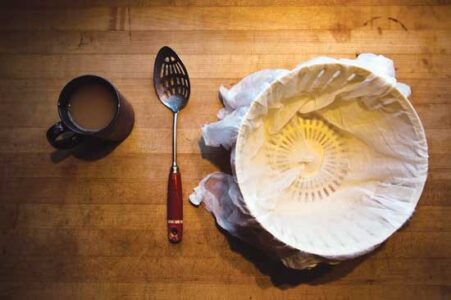Cheese in one hour? Is it really possible? It is! In some cases, you can have ready-to-eat cheese in well under an hour. One-hour cheese making, like any craft, requires certain tools, practices, and tricks — just stick to the simple guidelines below, and you’ll be a cheesemaker in no time.
Cheese Workspace
The parameters for prepping your space for making fresh cheese are far more flexible than if you were making aged cheese. Use the same cleanliness habits and common sense you would for any type of cooking — no bleach needed. Biodegradable soap, hot water, and fresh kitchen towels will do the trick.
Cheese Equipment
 Photo by Flickr/Brian Boucheron" width="550" height="367" data-tw-width="w-full lg:w-3/4 mx-auto" data-align="aligncenter"/>
Photo by Flickr/Brian Boucheron" width="550" height="367" data-tw-width="w-full lg:w-3/4 mx-auto" data-align="aligncenter"/> Most of the supplies you’ll need for the following recipes are already in your kitchen, and the remainder are easy to find at a local grocery store."/>
These micro-batch recipes call for a gallon or less of milk, and that makes gathering tools in an average kitchen a breeze — no need for 5-gallon vats here! Aside from common measuring spoons and cups, a large spoon, a colander, and bowls, you’ll need three additional tools.
- Cheesecloth. The disposable cheesecloth you’ll find at most grocery stores — with huge holes — will sadly let your precious curds slip through the “cracks.” Get your hands on reusable “butter muslin” or Grade 90# or 120# cheesecloth. In fact, a brand-new washed handkerchief or a lint-free tea towel will work better than the grocery-store gauze.
- Stockpot. An average stainless-steel or enameled pot is ideal when it comes to cheese making. The kind used to make pasta can usually hold a gallon of milk perfectly. If you must purchase one, select a pot with the thickest base you can afford, because thin bases tend to scorch milk. Avoid uncoated aluminum and cast-iron pots as well — they can corrode with acids and impart a metallic flavor.
- Thermometer. A thermometer will be invaluable while you’re learning. A common 5-inch metal probe meat thermometer, a simple digital thermometer, or a food-safe glass milk thermometer will do. An analog thermometer should span 0 to 220 degrees Fahrenheit with markings at least every 2 degrees.
Milk, Acid, Rennet
- Milk. Of course you’ll need milk. It can be store-bought or farm-fresh, raw or pasteurized, or even homogenized. Avoid ultra-pasteurized milk as it won’t coagulate properly. Organic milk isn’t always best, but local milk is usually less likely to be ultra-pasteurized. Grass-fed and local milk is the jackpot!
- Acids. Many cheese recipes use common ingredients, such as vinegar, citrus juice, and buttermilk, to coagulate milk, but if you continue your journey into the world of cheese making, you’ll encounter recipes that call for citric acid — a purified form of the weak acid naturally found in citrus fruits.
- Rennet. This is the compound of enzymes that transforms milk into a sturdy curd. You can find animal, microbial, and vegetarian rennet in tablet or liquid form, but for best results with the following recipes, I recommend that you use vegetarian rennet tablets. I use vegetarian rennet tablets because they keep for years in the freezer and because I have lacto-vegetarian friends who enjoy my cheese.
- Flair. Good additions to homemade cheese include herbs, spices, honey, fruit, and anything else you make (apple butter), enjoy (hot peppers), or grow (figs). They’ll make your cheese special! This is my favorite part.
No Time Like the Present

A general mystique surrounds the cheese-making process, but you shouldn’t fear failure. Don’t overthink it when you’re starting out. Dive in, take notes, and name your cheese after it’s made. “Cheese of the Day” is a perfectly fine title. Perhaps the greatest thing about one-hour cheese is that it’s all safe and edible, and you’ll only need 60 minutes to try again if you aren’t happy with your results.
One-Hour Cheese Recipes
Claudia Lucero is the entrepreneur behind Urban Cheesecraft and DIY Cheese Kits, and a frequent speaker at MOTHER EARTH NEWS FAIRS. Her book, One-Hour Cheese (Workman Publishing, 2017), is available in the MOTHER EARTH NEWS Store.




